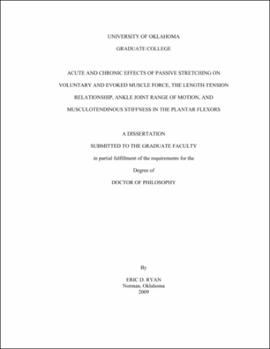| dc.description.abstract | The purposes of the present study were: (a) to examine the effects of prolonged passive stretching on the length-tension relationship under voluntary (maximal voluntary contraction (MVC) force) and evoked (single and tetanic twitch force) conditions, (b) to determine if four weeks of regular chronic stretching affects the magnitude of the stretching-induced deficit on MVC, single and tetanic twitch force, percent voluntary activation (% VA), electromyographic (EMG) amplitude of the soleus (SOL) and medial gastrocnemius (MG), range of motion (ROM), musculotendinous stiffness (MTS), and corrected calf girth, and (c) to examine the effects of acute versus chronic stretching on changes in ROM and MTS. Twenty-six healthy men volunteered for this investigation and were randomly assigned to either a stretch training (STR) group (mean±SD age = 22 ± 2 yrs; stature = 175 ± 8 cm; mass = 74 ± 12) or control (CON) group (21 ± 2 yrs; stature = 176 ± 7 cm; mass = 76 ± 11) for four weeks. At baseline (week 1) and post-testing (week 5) all subjects completed a flexibility and strength (voluntary and evoked) assessment prior to and following 20 min of passive stretching of the plantar flexor muscles on a custom-built load cell apparatus attached to a calibrated isokinetic dynamometer. To determine ROM and MTS, the dynamometer passively dorsiflexed the foot at 5˚۰s-1 from -20º of dorsiflexion to the maximum tolerable ROM (as acknowledged by the subjects). For the strength assessments, subjects performed a MVC and underwent a single and tetanic stimulus at each randomly-ordered joint angle (-19º, -9º, 1º, and 12º of dorsiflexion, where 0º = neutral ankle joint angle). The stretch training included four 135-s constant-torque passive stretches 3 times per week for 4 weeks. At weeks 1 and 5, from pre- to post-stretching voluntary and evoked force decreased across all joint angles, ROM increased, and MTS decreased, however there were no changes in EMG amplitude or % VA. Following 4 weeks of stretch training, the STR group showed increases in voluntary (MVC) and evoked (single and tetanic twitch) force production at all joint angles, increases in ROM, decreases in MTS, and increases in MG EMG amplitude, but no changes in % VA, SOL EMG amplitude, and corrected calf girth. For the CON group, there were no changes in MVC force, ROM, MTS, %VA, SOL EMG amplitude, and corrected calf girth, but increases in single and tetanic twitch force and EMG MG amplitude. For the length-tension relationship, voluntary and evoked force increased from shorter to longer muscle lengths (19° to 1°) and decreased at the longest muscle length (12°), whereas % VA and EMG MG amplitude decreased from the shortest to the longest muscle lengths. There were no acute or chronic stretching induced changes in the length-tension relationship. The results of the present study suggest due to the lack of changes in %VA and EMG amplitude and decreases in MTS from pre- to post-stretching, the stretching-induced force deficit may be more mechanical in origin. Chronic stretch training also does not appear to influence the stretching-induced force deficit or length-tension relationship. However, chronic stretch training appears to increase maximal force production at all joint angles, increase ROM, and decrease MTS in the plantar flexors with no changes in corrected calf girth. Therefore, it is possible chronic stretch training results in longitudinal hypertrophy (i.e. increased amount of sarcomeres in series), however future studies are needed to determine if there are in fact fascicle length changes following stretch training. | |
